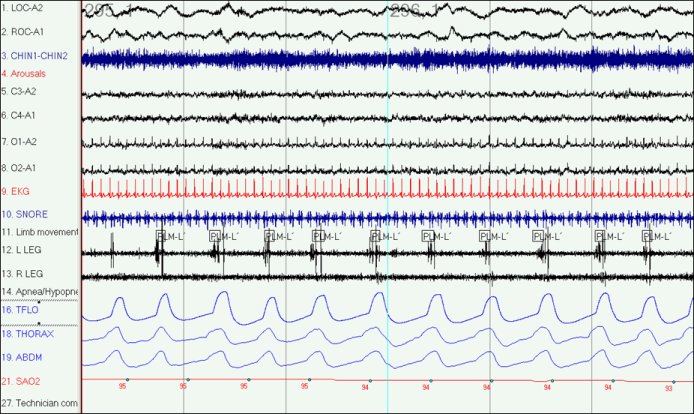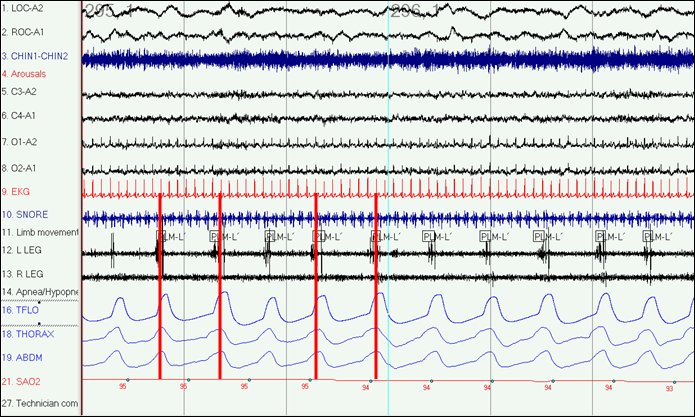Contributed by James A. Rowley, MD
The fragment shows 60 seconds of sleep during which the technician scored the leg channel events as periodic limb movements. However, it should be noted that the leg movements align with the respiratory channel (see the edited fragment above), indicating that these events are an artifact of respiratory movement, not periodic limb movements. In this case, the leg electrode wires were positioned across the chest in order to reach the electrode box lying on the chest, resulting in artifactual electrical activity in the left leg channel.
The identification of periodic limb movements was defined in a statement from the American Sleep Disorders Association (now the American Academy of Sleep Medicine; see Sleep 1993; 16:745-759). There are 2 key elements:
- Leg movement: burst of anterior tibilias muscle activity with a duration of 0.5 to 5 seconds and an amplitude of at least 25% of the leg movement recorded during patient calibration.
- Leg movements are periodic if there are ≥4 leg movements separated by at least 5 seconds and not greater than 90 seconds.
While the events shown could in theory meet the above definition, the limb movement rate would be 600 per hour (10 events in the 60 seconds shown), which is not physiologically possible. The rate and the clear association with respiratory events indicates that the events are artifact.
Recently, the World Association of Sleep Medicine provided alternative key elements for socring a leg movement. The main differences are that the duration of the burst can be from 0.5 to 10 sec, and the amplitude criterion has been changed to an absolute threshold of 8 mcV for onset (Sleep Med 2006;7:175).
The reader should be aware that the AASM is planning on updating scoring criteria for leg movements in 2007 as part of a larger project to update all scoring criteria. At this time, it is unknown if the AASM will keep the old scoring rules or adopt the new WASM rules. Therefore, the reader should plan to check the AASM website in mid-2007 for updates on the new scoring criteria.
Legend: LOC-A2: left oculogram; ROC-A1: right oculogram; CHIN1-CHIN2: chin EMG; Arousals: space for indicating arousals; C3-A2, C4-A1: central EEG leads; O1-A2, O2-A1: occipital EEG leads; EKG: electrocardiogram; SNORE: snore channel; Limb movement: space for indicating leg movements; L LEG: left leg EMG; R LEG: right leg EMG; Apnea/Hypopnea: space for indicating respiratory events; TFLO: thermistor flow channel; THORAX: thorax effort channel; ABDM: abdominal effort channel; SAO2: oxygen saturation channel; Technician comment: space for technician comments. PSG recorded using REMbrandt/Medcare software.





